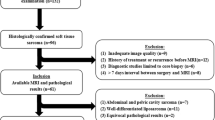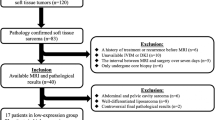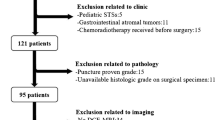Abstract
Objectives
To examine the correlation of diffusion-weighted and dynamic contrast-enhanced magnetic resonance imaging (MRI) parameters with Ki-67 labeling index (LI) in soft tissue sarcoma (STS).
Methods
The institutional review board approved this retrospective study, and the requirement for informed consent was waived. Thirty-six patients with STS who underwent 3.0-T MRI, including diffusion-weighted and dynamic contrast-enhanced MRI, between July 2011 and February 2018, were included in this study. The mean and minimum apparent diffusion coefficients (ADCs) (ADCmean and ADCmin, respectively), volume transfer constant, reflux rate, and volume fraction of the extravascular extracellular matrix of each lesion were independently analyzed by two readers. Their relationship with the Ki-67 LI was examined using Spearman’s correlation analyses. Differences between low- and high-proliferation groups based on Ki-67 LI were evaluated statistically. Optimal cut-off points were determined using the area under the curve analysis for significant parameters. Interobserver agreement was assessed with the intraclass correlation coefficient.
Results
ADCmean (ρ = − 0.333, p = 0.047) was significantly and inversely correlated with Ki-67 LI. The high-proliferation group showed a significantly lower ADCmean than did the low-proliferation group (median, 1.08 vs. 1.20; p = 0.048). When a cut-off ADCmean value of 1.16 × 10−3 mm2/s was used, the sensitivity, specificity, and area under the curve for differentiating low- and high-proliferation groups were 75.0%, 60.0%, and 0.712, respectively. Interobserver agreements between the two readers were almost perfect for all parameters.
Conclusions
ADCmean was correlated with Ki-67 LI and could help differentiate between STS with low and high proliferation potential.
Key Points
• ADC mean was significantly and inversely correlated with Ki-67 labeling index in soft tissue sarcoma.
• In the high-proliferation group, ADC mean values were significantly lower than those of the low-proliferation group.






Similar content being viewed by others
Abbreviations
- ADC:
-
Apparent diffusion coefficient
- AIF:
-
Arterial input function
- DW:
-
Diffusion-weighted
- FNCLCC:
-
French Federation of Cancer Centers Sarcoma Group
- ICC:
-
Intraclass correlation coefficient
- LI:
-
Labeling index
- MRI:
-
Magnetic resonance imaging
- STS:
-
Soft tissue sarcoma
- TE:
-
Echo time
- TR:
-
Repetition time
References
Fletcher CDM, Bridge JA, Hogendoorn PCW, Mertens F (2013) WHO classification of tumours of soft tissue and bone. IARC Press, Lyon
Trojani M, Contesso G, Coindre JM et al (1984) Soft-tissue sarcomas of adults; study of pathological prognostic variables and definition of a histopathological grading system. Int J Cancer 33:37–42
Neuville A, Chibon F, Coindre JM (2014) Grading of soft tissue sarcomas: from histological to molecular assessment. Pathology 46:113–120
Engellau J (2004) Prognostic factors in soft tissue sarcoma. Tissue microarray for immunostaining, the importance of whole-tumor sections and time-dependence. Acta Orthop Scand Suppl 75:1–52
Tanaka K, Hasegawa T, Nojima T et al (2016) Prospective evaluation of Ki-67 system in histological grading of soft tissue sarcomas in the Japan Clinical Oncology Group Study JCOG0304. World J Surg Oncol 14:110
Dowsett M, Nielsen TO, A'Hern R et al (2011) Assessment of Ki67 in breast cancer: recommendations from the international Ki67 in breast cancer working group. J Natl Cancer Inst 103:1656–1664
Hasegawa T, Yamamoto S, Yokoyama R, Umeda T, Matsuno Y, Hirohashi S (2002) Prognostic significance of grading and staging systems using MIB-1 score in adult patients with soft tissue sarcoma of the extremities and trunk. Cancer 95:843–851
Rudolph P, Kellner U, Chassevent A et al (1997) Prognostic relevance of a novel proliferation marker, Ki-S11, for soft-tissue sarcoma. A multivariate study. Am J Pathol 150:1997–2007
Hasegawa T, Yokoyama R, Lee YH, Shimoda T, Beppu Y, Hirohashi S (2000) Prognostic relevance of a histological grading system using MIB-1 for adult soft-tissue sarcoma. Oncology 58:66–74
Levine EA, Holzmayer T, Bacus S et al (1997) Evaluation of newer prognostic markers for adult soft tissue sarcomas. J Clin Oncol 15:3249–3257
Hoos A, Stojadinovic A, Mastorides S et al (2001) High Ki-67 proliferative index predicts disease specific survival in patients with high-risk soft tissue sarcomas. Cancer 92:869–874
Domingues R, Costa F (2018) Advanced musculoskeletal MR imaging, an issue of magnetic resonance imaging clinics of north America. Elsevier Health Sciences
Subhawong TK, Jacobs MA, Fayad LM (2014) Diffusion-weighted MR imaging for characterizing musculoskeletal lesions. Radiographics 34:1163–1177
Breault SR, Heye T, Bashir MR et al (2013) Quantitative dynamic contrast-enhanced MRI of pelvic and lumbar bone marrow: effect of age and marrow fat content on pharmacokinetic parameter values. AJR Am J Roentgenol 200:W297–W303
Tofts PS (1997) Modeling tracer kinetics in dynamic Gd-DTPA MR imaging. J Magn Reson Imaging 7:91–101
Yoon MA, Chee CG, Chung HW et al (2019) Added value of diffusion-weighted imaging to conventional MRI for predicting fascial involvement of soft tissue sarcomas. Eur Radiol 29:1863–1873
Sagiyama K, Watanabe Y, Kamei R et al (2017) Multiparametric voxel-based analyses of standardized uptake values and apparent diffusion coefficients of soft-tissue tumours with a positron emission tomography/magnetic resonance system: preliminary results. Eur Radiol 27:5024–5033
Chhabra A, Ashikyan O, Slepicka C et al (2019) Conventional MR and diffusion-weighted imaging of musculoskeletal soft tissue malignancy: correlation with histologic grading. Eur Radiol 29:4485–4494
Razek AA (2012) Diffusion magnetic resonance imaging of chest tumors. Cancer Imaging 12:452–463
Siemann DW (2011) The unique characteristics of tumor vasculature and preclinical evidence for its selective disruption by tumor-vascular disrupting agents. Cancer Treat Rev 37:63–74
Lee JH, Yoon YC, Jin W, Cha JG, Kim S (2019) Development and validation of nomograms for malignancy prediction in soft tissue tumors using magnetic resonance imaging measurements. Sci Rep 9:4897
Jeon JY, Chung HW, Lee MH, Lee SH, Shin MJ (2016) Usefulness of diffusion-weighted MR imaging for differentiating between benign and malignant superficial soft tissue tumours and tumour-like lesions. Br J Radiol 89:20150929
Subhawong TK, Jacobs MA, Fayad LM (2014) Insights into quantitative diffusion-weighted MRI for musculoskeletal tumor imaging. AJR Am J Roentgenol 203:560–572
Fram EK, Herfkens RJ, Johnson GA et al (1987) Rapid calculation of T1 using variable flip angle gradient refocused imaging. Magn Reson Imaging 5:201–208
Tofts PS, Brix G, Buckley DL et al (1999) Estimating kinetic parameters from dynamic contrast-enhanced T(1)-weighted MRI of a diffusable tracer: standardized quantities and symbols. J Magn Reson Imaging 10:223–232
Parker GJ, Roberts C, Macdonald A et al (2006) Experimentally-derived functional form for a population-averaged high-temporal-resolution arterial input function for dynamic contrast-enhanced MRI. Magn Reson Med 56:993–1000
Song Y, Yoon YC, Chong Y et al (2017) Diagnostic performance of conventional MRI parameters and apparent diffusion coefficient values in differentiating between benign and malignant soft-tissue tumours. Clin Radiol 72:691 e10
Oka K, Yakushiji T, Sato H et al (2011) Usefulness of diffusion-weighted imaging for differentiating between desmoid tumors and malignant soft tissue tumors. J Magn Reson Imaging 33:189–193
Crombe A, Marcellin PJ, Buy X et al (2019) Soft-tissue sarcomas: assessment of MRI features correlating with histologic grade and patient outcome. Radiology 291:710–721
Landis JR, Koch GG (1977) The measurement of observer agreement for categorical data. Biometrics 33:159–174
Zhang XY, Sun YS, Tang L, Xue WC, Zhang XP (2011) Correlation of diffusion-weighted imaging data with apoptotic and proliferation indexes in CT26 colorectal tumor homografts in balb/c mouse. J Magn Reson Imaging 33:1171–1176
Mori N, Ota H, Mugikura S et al (2015) Luminal-type breast cancer: correlation of apparent diffusion coefficients with the Ki-67 labeling index. Radiology 274:66–73
Surov A, Caysa H, Wienke A, Spielmann RP, Fiedler E (2015) Correlation between different ADC fractions, cell count, Ki-67, Total nucleic areas and average nucleic areas in meningothelial meningiomas. Anticancer Res 35:6841–6846
Sun M, Cheng J, Zhang Y et al (2018) Application of DWIBS in malignant lymphoma: correlation between ADC values and Ki-67 index. Eur Radiol 28:1701–1708
Yeo DM, Oh SN, Jung CK et al (2015) Correlation of dynamic contrast-enhanced MRI perfusion parameters with angiogenesis and biologic aggressiveness of rectal cancer: preliminary results. J Magn Reson Imaging 41:474–480
Surov A, Meyer HJ, Gawlitza M et al (2017) Correlations between DCE MRI and histopathological parameters in head and neck squamous cell carcinoma. Transl Oncol 10:17–21
Jansen JF, Carlson DL, Lu Y et al (2012) Correlation of a priori DCE-MRI and (1)H-MRS data with molecular markers in neck nodal metastases: initial analysis. Oral Oncol 48:717–722
Aryal MP, Nagaraja TN, Keenan KA et al (2014) Dynamic contrast enhanced MRI parameters and tumor cellularity in a rat model of cerebral glioma at 7 T. Magn Reson Med 71:2206–2214
Langer DL, van der Kwast TH, Evans AJ et al (2010) Prostate tissue composition and MR measurements: investigating the relationships between ADC, T2, K(trans), v(e), and corresponding histologic features. Radiology 255:485–494
Mills SJ, Soh C, Rose CJ et al (2010) Candidate biomarkers of extravascular extracellular space: a direct comparison of apparent diffusion coefficient and dynamic contrast-enhanced MR imaging--derived measurement of the volume of the extravascular extracellular space in glioblastoma multiforme. AJNR Am J Neuroradiol 31:549–553
Zhao F, Ahlawat S, Farahani SJ et al (2014) Can MR imaging be used to predict tumor grade in soft-tissue sarcoma? Radiology 272:192–201
Ahn S, Lee J, Cho MS, Park S, Sung SH (2018) Evaluation of Ki-67 index in core needle biopsies and matched breast cancer surgical specimens. Arch Pathol Lab Med 142:364–368
Funding
The authors state that this work has not received any funding.
Author information
Authors and Affiliations
Corresponding author
Ethics declarations
Guarantor
The scientific guarantor of this publication is Young Cheol Yoon.
Conflict of interest
The authors of this manuscript declare no relationships with any companies, whose products or services may be related to the subject matter of the article.
Statistics and biometry
No complex statistical methods were necessary for this paper.
Informed consent
Written informed consent was waived by the Institutional Review Board.
Ethical approval
Institutional Review Board approval was obtained.
Study subjects or cohorts overlap
We declare that some of our subjects overlap with the previously reported study [Lee JH, Yoon YC, Jin W, Cha JG, Kim S (2019) Development and validation of nomograms for malignancy prediction in soft tissue tumors using magnetic resonance imaging measurements. Sci Rep 9:4897]. In the prior study, we reported on 236 patients. Among them, 25 patients were included in the current study. The prior study developed, validated, and compared nomograms for malignancy prediction in soft tissue tumors using conventional and diffusion-weighed MRI measurements. On the contrary, the current study focuses on correlation between MRI parameters and Ki-67 labeling index using dynamic contrast-enhanced MRI as well as diffusion-weighed MRI.
Methodology
• retrospective
• observational
• performed at one institution
Additional information
Publisher’s note
Springer Nature remains neutral with regard to jurisdictional claims in published maps and institutional affiliations.
Rights and permissions
About this article
Cite this article
Lee, J.H., Yoon, Y.C., Seo, S.W. et al. Soft tissue sarcoma: DWI and DCE-MRI parameters correlate with Ki-67 labeling index. Eur Radiol 30, 914–924 (2020). https://doi.org/10.1007/s00330-019-06445-9
Received:
Revised:
Accepted:
Published:
Issue Date:
DOI: https://doi.org/10.1007/s00330-019-06445-9




